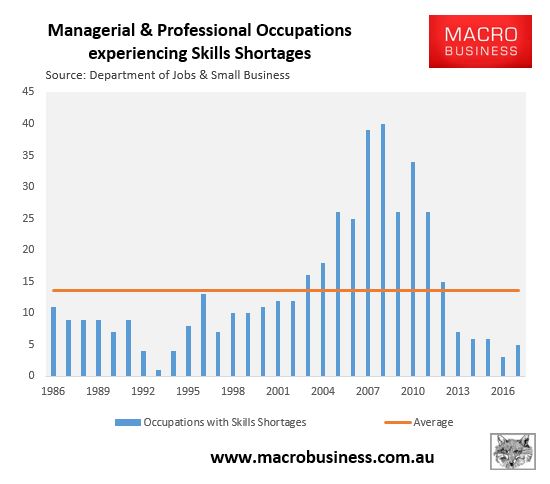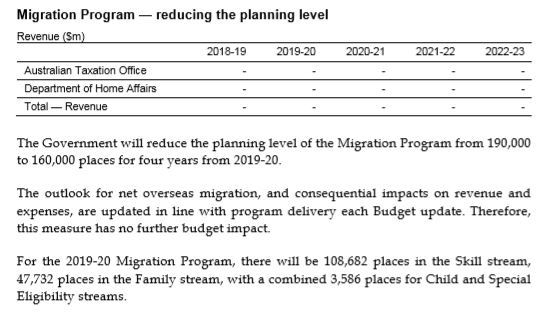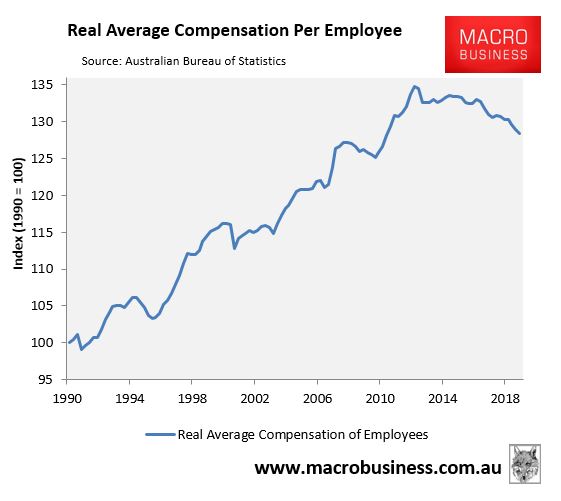For years, MB has questioned the efficacy of the Migration Council of Australia, which purports to be an “an independent, non-partisan, not-for-profit body established to enhance the productive benefits of Australia’s migration and humanitarian programs”.
The Migration Council is chaired by one of Australia’s biggest business lobbyists, Innes Willox, who is also CEO of the Australian Industry Group.
For years, Innes Willox has lobbied against laws to prevent wage theft, lobbied against stricter labour hire rules, and has spread copious propaganda about skills shortages.
In the wake of Tuesday’s Federal Budget, Willox was at it again, attacking the Coalition’s tiny cut to Australia’s permanent migrant intake:
“The reduction in the permanent immigration intake is of considerable concern for the many businesses facing skill shortages across a wide range of occupations. Extending the reduction for a number of years carries risks and will lift the dependency on temporary migration”.
This, of course, follows the Migration Council CEO, Carla Wilshire’s, big business lobbying last month:
The Migration Council Australia said the drop in the intake would undermine the labour market and business confidence.
Chief executive Carla Wilshire said the migration program “adds significantly to our GDP and provides an underlying level of economic growth critical for our long-term economic outlook”.
Let’s ask the question once more: does the Migration Council exist as a lobby to benefit migrants and Australians or is it only there to enable business to exploit cheap labour to the detriment of migrants and the Australian community?
Because any objective analysis of the facts would conclude that Australia is not suffering “skill shortages across a wide range of occupations”, thereby necessitating ongoing mass immigration.
First, average employee compensation has been falling for more than six years when adjusted for inflation:
If skills shortages were so pervasive, wouldn’t wages be getting bid up and not be falling?
Second, the Department of Jobs & Small Business’ own time-series database tracking skills shortages across occupations shows that in 2017, skills shortages across managerial and professional occupations were running well below the 31-year average at close to recessionary levels:

This is important because of the 111,099 permanent visas handed out under the skilled stream in 2017-18, three-quarters were for professionals and managers, where skills shortages are largely non-existent, as shown above.
Moreover, the top five occupations granted visas under the skilled stream in 2017-18 were:
- Accountants (3505)
- Software Engineer (3112)
- Registered Nurses (1561)
- Developer Programmer (1487)
- Cook (1257)
According to the Department of Jobs and Small Business’ list, not one of these professions was deemed to be in shortage over the four years to 2017, whereas Software Engineer has never been in shortage in the entire 31- year history of the series!
The news is no better for the Temporary Skill Shortage (TSS) visa program. According to the Department of Home Affairs, there were 34,450 primary visas granted in 2017-18, of which 25,620 (74%) were for professionals and managers; again where skills shortages are largely non-existent.
The failure of Australia’s so-called skilled migration program to alleviate genuine skills shortages should not be surprising given almost any occupation is eligible for visas. Specifically:
- 216 occupations are eligible for the Employer Nomination Scheme visa (subclass 186)
- 673 occupations are eligible for the Regional Sponsored Migration Scheme (subclass 187)
- 212 occupations are eligible for the Skilled Independent Visa (subclass 189), the Temporary Graduate Visa (subclass 485), and the Skilled Regional (Provisional) Visa (subclass 489)
- 427 occupations are eligible for the Skilled Nominated Visa (subclass 190)
- 504 occupations are eligible for the Skilled Regional (Provisional) Visa (subclass 489)
- 508 occupations are eligible for the Temporary Skill Shortage (TSS) visa (subclass 482).
The above lists have no requirement that the occupations are actually experiencing skills shortages. This means that visas can be used by employers who wish to access foreign labour for an ulterior motive, such as to lower wage costs.
Let’s also not forget that the Morrison Government has recently opened the floodgates to a variety of temporary work visas, and this helps to explain why net overseas migration is actually budgeted to increase, not fall, over the forward estimates:

When big business lobbyists like Innes Willox complain about skills shortages, it’s really code for wanting access to more cheaper migrant workers in order to keep wage costs down.
unconventionaleconomist@hotmail.com


